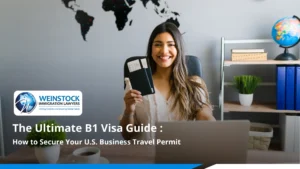H-1B VISA DENIALS CONTINUE TO INCREASE FOR COMPANIES
H-1B VISA DENIALS CONTINUE TO INCREASE FOR COMPANIES
U.S. Citizenship and Immigration Services (USCIS) continues H-1B visa denials, including for high-skilled foreign nationals sponsored by many of the best companies in the world, according to a new analysis. The overall trend for businesses under the Trump administration is to make life more difficult for companies hiring foreign-born scientists and engineers. A recent court settlement may result in lower denial rates for companies later this year.
“Analyzing data through the second quarter of FY 2020 finds companies continue to be denied at much higher rates than in the years before when Donald Trump became president and instituted new policies,” according to a new analysis from the National Foundation for American Policy. The report, based on USCIS data from the H-1B Employer Data Hub, focused on H-1B petitions for “initial” employment, which are used primarily for new jobs, typically a case that would count against the H-1B annual limit.
Among the findings in the new analysis:
- “All the top 25 employers of new H-1B professionals had higher denial rates for H-1B petitions for initial employment in FY 2020 (through the second quarter) than in FY 2015. (These are the top 25 companies with the newest H-1B petitions approved for initial employment in FY 2019.)
- “20 of the 25 top companies had H-1B denial rates for initial employment at least ten percentage points higher in FY 2020 (through the second quarter) than in FY 2015. That includes large technology companies such as Cisco and Google.
- “The highest denial rates continue to be for companies that provide information technology or other business services to American companies. The data indicate USCIS has established a different standard for deciding cases for companies that provide information technology (IT) services. Immigration law does not have a different standard for adjudications based on the type of firm or the location work that will be performed.
- “The denial rate for initial employment through the second quarter of FY 2020 when compared to FY 2015 increased by 20 percentage points or more for ten significant companies that provide IT services or other business consulting services.
- “Denial rates for initial employment for H-1B petitions were generally between 1% and 5% in FY 2015 for the top employers of H-1B professionals, compared to denials rates that ranged mostly from 15% to as high as 59% through the first two quarters of FY 2020.
- “In FY 2015, 16 of the 25 top companies had denial rates of 2% or lower for H-1B petitions for initial employment.”
Table 1: Denial Rates for H-1B Petitions for Initial Employment
|
Source: USCIS, National Foundation for American Policy. *FY 2020 data through the second quarter of FY 2020. Data extracted and analyzed from USCIS H-1B Employer Data Hub. Percentages are rounded off. Note: IBM and IBM Private India were combined, as were Amazon and Amazon Corporate, and Larsen & Toubro and L&T Technology Services. Employers listed by the number of new H-1B petitions approved in FY 2019. Get the data Created with Datawrapper
What will the third and fourth quarters of FY 2020 show? Some recently released USCIS data provide a clue, but the interpretation is needed. It can be challenging to interpret H-1B data USCIS releases outside the H-1B Employer Data Hub because 1) when USCIS releases data, it mixes in both initial (for primarily new employees) and continuing (for mostly existing employees) H-1B petitions and 2) since there are often more “continuing” H-1B cases, and continuing petitions have lower denial rates, combining the two types can obscure the denial rate for H-1B petitions for initial employment.
For example, the overall denial rate for H-1B petitions (for both initial and continuing cases) in the first quarter of FY 2020 was 16.6% in a document released by USCIS. However, the denial rate for just H-1B petitions for initial employment was 30% in the same quarter.
USCIS recently released data for the third quarter of FY 2020 that showed an overall H-1B denial rate of only 4.1%. Still, we do not know the denial rate for H-1B petitions for initial employment for the quarter because USCIS combined initial and continuing cases.
The likely explanation for the lower denial rate in the third quarter of FY 2020 can be found in the National Foundation for American Policy’s breakdown of the four quarters of FY 2019, which showed a denial rate for initial employment of 10% in the third quarter of FY 2019 – a high percentage compared to earlier years but much lower than other quarters during the Trump era.
The reason for the lower denial rate? The third quarter takes place in April, May, and June, during the period after the H-1B “lottery” selection, which happens each year because the demand for H-1B visas exceeds the annual limit. In the third quarter of FY 2019 and FY 2020, it appears USCIS adjudicators approved the H-1B petitions selected in the H-1B lottery considered easiest to approve and delayed or issued a Request for Evidence for other petitions. The supporting evidence? The percentage of completed cases with a Request for Evidence was about 27% in the third quarter of FY 2019 vs. 60% in the first quarter of FY 2019. Similarly, in the third quarter of FY 2020, 20% of the completed H-1B cases had a Request for Evidence vs. 47% in the first quarter of FY 2020.
Table 2: Denial Rate By Quarters in FY 2019 for H-1B Petitions for Initial (New) Employment
| FISCAL YEAR | DENIAL RATE |
| 1st Quarter (FY 2019) | 32% |
| 2nd Quarter (FY 2019) | 35% |
| 3rd Quarter (FY 2019) | 10% |
| 4th Quarter (FY 2019) | 15% |
| OVERALL FY 2019 | 21% |
Source: USCIS, National Foundation for American Policy. Percentages are rounded off. Data extracted and analyzed from USCIS H-1B Employer Data Hub. Approvals and denials include petitions filed for individuals employed at universities and non-profit and government research institutes, which are exempt from numerical limits. Get the data Created with Datawrapper
Looking back at the fourth quarter of FY 2019, the denial rate for H-1B petitions for initial employment rose to 15% (from 10% in the third quarter). We may see a similar pattern in the fourth quarter of FY 2020.
There is a significant development to watch for in the fourth quarter of FY 2020 and the first quarter of FY 2021 – the impact of the settlement between USCIS and the business group ITServe Alliance. As part of the legal settlement, USCIS issued a new policy memo (on June 17, 2020) and withdrew a February 2018 memo on “Contracts and Itineraries Requirements for H-1B Petitions Involving Third-Party Worksites” that was blamed, along with the USCIS interpretation of the “Neufeld” memo (also withdrawn) for much of the increase in H-1B denial rates during the Trump administration.
The denial rate for H-1B petitions for initial employment increased from 6% in FY 2015, before Donald Trump took office, to 29% through the second quarter of FY 2020. Given the Trump administration is blocking the entry of the most highly skilled foreign-born individuals who apply for visas – on O-1 and H-1B – it is not clear if Trump officials will still say that the administration favors “merit-based” immigration.
There are two additional H-1B developments to watch before the end of 2020. First, courts and the November election will determine the fate of the June 2020 presidential proclamation to suspend the entry of foreign nationals on H-1B, L-1, and other temporary visas. Second, the administration may attempt to issue regulations to restrict H-1B visas before the end of the year. How much more restrictive U.S. immigration policy becomes for factors will determine companies out of their control.
The Weinstock Immigration Lawyers Vision:
Case approval uncertainty with USCIS, based on previous analysis, is now a fact that we see regularly. Throughout these continuous changes, Weinstock Immigration Lawyers has prevailed in delivering the final expected results to its clients, having filed hundreds of H-1B applications with a nearly perfect success rate. Our services are complemented by the dedication, professionalism, and effective case by case personal attention, standards we promote, and put in practice with every client. Weinstock Immigration Lawyers’ readiness to perform, in combination with these guidelines, is a proven mix for success.
Footnote: These cases do not include the success rate of being “selected” in the H-1B CAP lottery. This only includes cases exempt from the CAP or cases selected.
Source: economictimes.indiatimes.com, Lexology.com, Forbs.com
Related posts

J-1 Visa Requirements: Everything You Need to Know Before You Apply
If you are planning to study, teach, intern, or conduct research in the United States as part of a cultural or educational exchange program, the

The Ultimate B1 Visa Guide: How to Secure Your U.S. Business Travel Permit
Overview Traveling to the United States for business is a vital part of many global careers. Whether you’re attending a conference, meeting with partners, or

The Complete K1 Visa Guide: Bringing Your Fiancé to the U.S.
Overview Planning to bring your fiancé to the United States? You’re in the right place. This guide walks you through everything from eligibility to filing,
